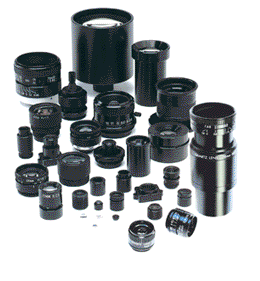High resolution lenses for machine vision — standard and custom lens design
Industrial Robots Enhance Automation
High Resolution Lenses for machine vision, instrumentation, inspection and vibration-sensitive applications. Standard and custom hi-res lens assemblies.

Industrial Robots
Robotic equipment has helped automate tasks in industrial settings since the early 1960s. The first industrial robot was deployed in a General Motors plant as a die casting machine. Advances in robotic technology have made industrial robots more affordable and a more viable option in machining, even though the six-axis articulated arm design has not evolved much over the past ten years.
The investment made in an industrial robot can help machine owners save money on employee costs and reduce time on the production line. Factor in that automation takes human error out of the equation by producing high quality parts with more reliable results, it’s easy to see why an investment in automation and robotics benefits a manufacturers’ bottom line.
Here are a few steps toward implementation of automation on the factory floor:
- Consult with the shop floor workers; they are the best source for production methods currently employed. The worker is experienced in the nuances of what works and what doesn’t and can provide insight into what could be easily automated. Workers that perform manual processes to complete the production of an item understand the specifications and configurations necessary to make the components.
- Work with industrial robotic programmers that understand your unique processes and the components necessary to manufacture the parts for your firm. A programmer that has experience in both operating and programming a robotic welder more easily handles transforming a manual welding procedure into a robotic welding procedure. Select a floor worker to work alongside the programmer to make the process and the steps involved logical when it comes to integrating the two processes.
- Training on the robotic automation needs to be part of the installation process. Make certain the robotic supplier provides hands-on training and support during the installation process; this will minimize downtime because of mechanical issues caused by human operator error. The person chosen to receive the training should be the one who will be the operator following automation. Groundwork training and understanding of how the robotic automation works and how it interacts with equipment you currently have should be a turnkey solution. Ease of use should be part of the equation when integrating a robotic system. Remember too, that routine maintenance by the provider of the robotic equipment should be part of the contract; robotic automation systems have been damaged by individuals performing maintenance that haven’t received proper training.
- Determine repeatability and quality issues with your robotic automation. Because robotic systems are designed to perform repetitive tasks you need to ask what the repeatability and accuracy rates are. When performing at optimal levels, robotic systems produce parts that are superior to manual production. The uses of touch sensors and seam tracking compensates for manual weld joints. Pay close attention to the lasers, welding torches and welding power used in the robotic system you’re purchasing.
- Calculate ROI before signing a contract. Steady growth and improvements in the robotic industry over the past decade mean the systems are more cost effective and are able to handle more complex production tasks at a lower overall cost. Consider that a robotic welder can do the work of five manual welders and you can see the cost savings at a glance. Efficiency, productivity and higher quality output of parts are certainly advantages to the installation of robotic equipment and when you weigh in the idea that with higher quality it could mean an increased demand for your products and you can see the cost benefits of this technology.